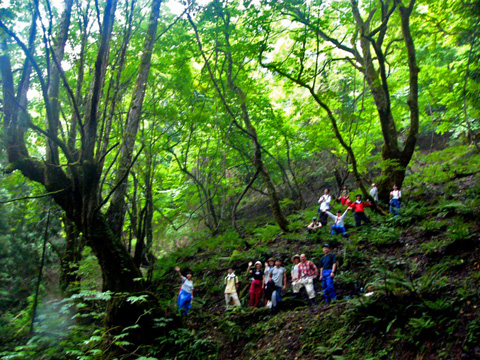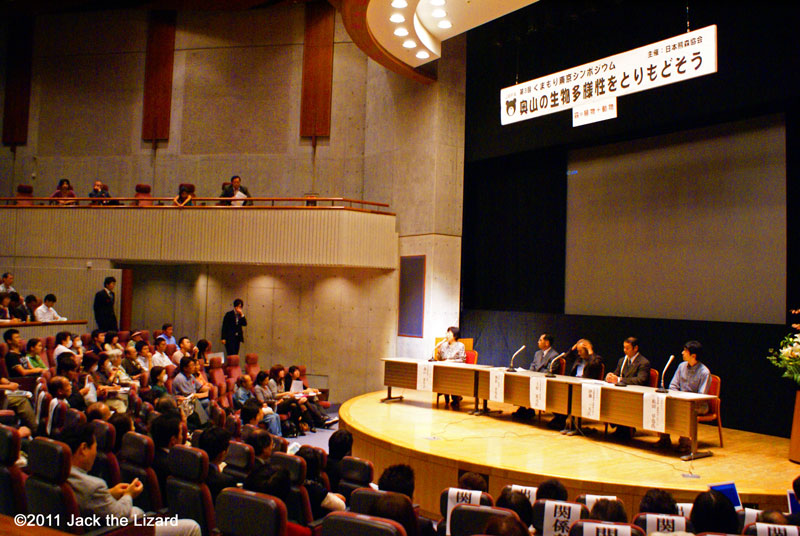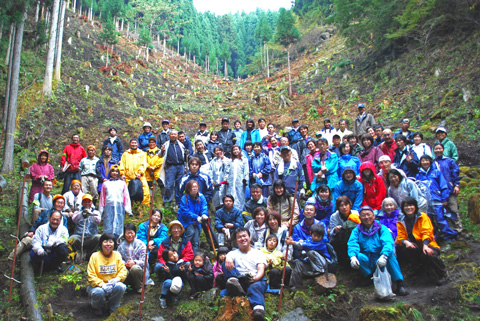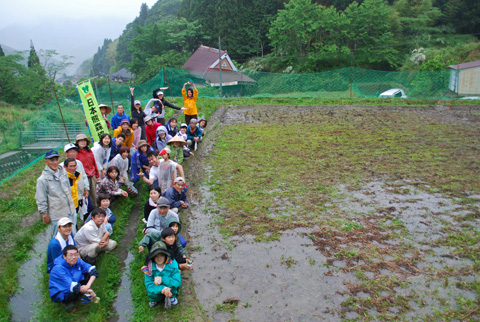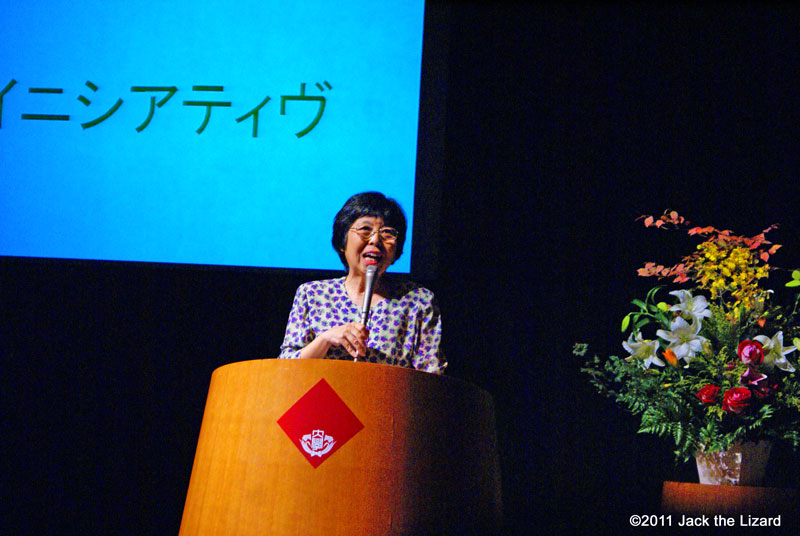
|
|
|
|
Our future was protected by high school students.
|
In 1994, the Ministry of the Environment banned the Asian black bear hunting in Hyogo Prefecture. The by-law was passed by high school students and their teacher. In 1997, Japan Bear & Forest Society was established by Ms. Mariko Moriyama in Nishinomiya City, Hyogo Prefecture which is about 265 mile (425km) west from Tokyo. Moriyama was used to be a science teacher of Muko-higashi Junior High School. “The passion of my students pushed me to the movement of natural environment conservation. I was reluctant first because of my busy schedule. I also wanted to keep distance from many of heart breaking stories of wild bears and animals,” said Moriyama. The society has developed since then and more than 20,000 members have been enrolled in Japan by now. 
|
|
This is what we do. |

|
Japan Bear & Forest Society is not the group protecting bears only. While protecting bears, the primeval forests have to be protected as well. Bear needs balanced environment to live in the wild, so the society’s activity has 5 basic elements; forest restoration, natural farming, wildlife rescue, invasive species measures and remote mountain trust. First of all, Forest restoration requires diversified plants and trees on mountains just as they used to be. However most of forests have many of cedars and Japanese cypress after the national forest development for lumbers. The society looks forward to have forests which have variety of broad-leaved trees such as Quercus serrata Murray, Quercus crispula and the Sawtooth Oak. These trees provide food such as fruits and nuts for wild animals. It is also essential to communicate with local people to look for the way to share the environment with wildlife such as bears, deer monkeys, hogs, racoon dogs and so on. Second, Natural farming is the strategy to grow crops using only natural nutritious water coming through soil in the mountains without fertilizer and farm pesticide. Healthy farming is appreciated by people in the big cities, and the natural farming gives opportunity for people in town to connect with the forests where wildlife lives. The third is invasive species issue. It is almost impossible to get rid of all the invasive species that have been adapted and included in the food web in the wild nature of Japan. So the society requests the national and local governments to avoid unnecessary killing but wait to let them settled in the new balanced ecosystem, while the society demands to forbid importing of exotic animals. Finally Remote mountain trust is one of the biggest projects of the society. The project is to purchase the entire of natural forests to protect its’ environment and animals living there. At this moment, the society possesses and manages about 12.67 square km (3,131 acre) of forests in the country. |

|
Quick decisions help people connected. |
Even after the society was established, Moriyama had hard time to initiate her activities. She found quit a lot of people understood about her conservation activities, but fundraising was another story. Primarily, it cost a lot for Moriyama and the society members to visit rural areas far away in the prefecture. It was also time consuming to visit and research the forest of each area. Sometimes Moriyama needed to go to Tokyo to meet members of Congress to change the laws. Expenses were far more than income. But one day, she came to a turning point. She had a presentation at the convention of Rotary International Hyogo local club. At beginning, she was told to finish her presentation within 15 minutes in front of 1,200 of audiences. She convinced the organizer that 15 minutes was not enough to explain about anything. After the negotiation, surprisingly 90 minutes was given to her. So she brought 5 of her young students with her onto the stage and told all the stories that they wanted the audience to know. After the presentation, one of the members of the Rotary International approached her and asked for the enrolment to the society and offered donation, then another man came, and another… Moriyama did not expect that, so she said “I am very happy about your offers, but please wait a minutes. You may decide after knowing about our society more.” One gentleman interrupted her talk and said, “Ms. Moriyama, we all are CEOs of companies. If we do not have total confidence about our own decision, it is impossible to run business. When we find something right, we make decisions right away. Do you understand?”” Japan Bear & Forest Society has been expanded dramatically since then. |
If we keep talking, people will understand.
When she visits remote area, she is sometimes told this. “Don’t you understand the farmers’ feeling? We spent so much time end effort to grow our crops. Don’t you think we are sad to see our faming products damaged by wild animals? You are just visiting here from big city. We don’t like you saying animals need to be protected. You don’t know anything about the life of farmers.” This is heavy blow to the members of Japan Bear & Forest Society and sometimes the members are apt to agree with farmers even though they visit there to discuss about the issue. So the members have spent some time and kept talking with farmers and local people. Through long discussions, both sides could understand each other then started to look for the idea to protect farming products as well as wild animals. At first Moriyama’s father was also a farmer and against to his daughter’s activity, but eventually started supporting her. The mountains in Japan were highly productive before. But since the country planted conifers for timber in the most of the mountains, animals cannot find any food in the forests. Consequently they come down from mountains to look for foods. Whatever they find edible, they eat even though it is human crops. There is no choice for animals. “Of course that is a big trouble for humans, but we would like to share the land friendly with animals. We used to do that before”, said Moriyama. As the solutions, the society and local people started to restore productivity of the mountains for wild animals, rebuild walls to protect farm products from hogs, spread net around the farm yards and so on. |
Just Do It |

|
Japan Bear & Forest Society does its own researches and studies with support from scientists, but most important things for the society is “making actions”. The year of 2006 was remarkable for the society. That year trees in the deep mountains of some area could not have fruits and nuts many enough for wild animals in autumn. As the result bears came closer to villages and so many hunters enter the mountains to get rid of them for humans’ safety. The society immediately decided to brings acorns to where bears appeared such as Fukui Prefecture, Ishikawa Prefecture and Toyama Prefecture. Acorns were sent to the society from all over the country by people who wish the bear’s survival. However this action was criticised on the issue of invasive plants. Some thought that action could cause another problem that foreign acorns could damage the local ecosystem of the forests. So, the society left acorns in the forests at the right timing that the temperature is too low for acorns to germinate. The society also carefully chose the right acorn which is Quercus serrata Murraray. This acorn is genetically same no matter where it had grown in Japan. On the other hand, acorns of Japanese Beech were avoided because each indigene has different DNA. The participants left acorns on the bears’ path ways, and returned to the spots to check the leftover, droppings around the spots and any signs of animals. They found all of were gone and only shells were left. They also found foot prints and droppings of bears, mice and others. It is a hard work to bring huge amount of acorns into mountains. But the participants learn a lot about nature and balance through this job, and relationship with local people and participants get stronger, and start loving our nature through the job. |
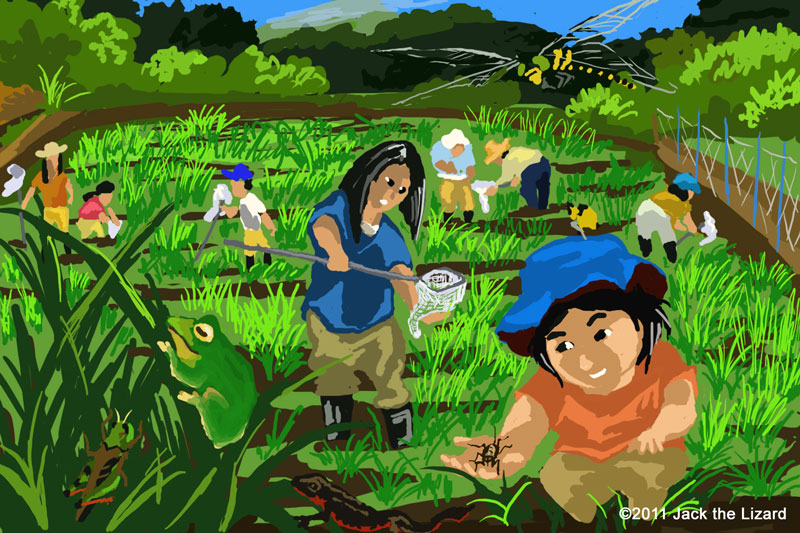
Research of animals in rice field. It is fun for not only children but adults. The participants find Japanese tree frogs, predaceous diving beetles, river snails, dragonfly larvae, eastern pale clouded yellow butterfly, and more.
|
Water, forests and our lives
One day Moriyama had a presentation in Osaka. She felt the audience was not into it. Actually the audience could not find any connection between their daily lives in big cities and what actually happening in remote forests. City of Osaka has waterworks connected to Lake Biwa. More than 120 rivers run into the largest lake in Japan, and the rivers are from remote forests. Rain water is absorbed in the soil of forests. Wild forests have high capacity to keep much water in the soil and percolate to rivers slowly. However the forests have been developed and planted conifers for lumber. The forest like that has just thin layer of its soil because conifers cover trees and plants on the ground level from getting sun lights. Since roots cannot grip the ground hard enough, conifers are vulnerable too. As the result, rivers have gradually lost the quantity of water running through. Moreover afforested mountains have topsoil which is easily slide off in the case of heavy rain, flush flood likely occur in this condition. People in the big cities need to be aware the fact that their lives are directly connected to remote forests via water. Wild forests cannot grow without wild animals and insects. Large mammals such as bears and deer walk in the forest and break little branches and bushes or sometimes knock down trees. That allows sunshine penetrates into deep forest and low bush and grass can grow. Their excrement left behind will be fertilizer for the plants. Birds and animals eat nuts and seeds and also carry them to new locations, and the seeds will sprout there. At the same timing of sprout, insects hatch. New sprouts are fresh and soft for new born larvae. Bees carry pollen that will create new seeds. Forests grow, and everything in the forests is closely connected to our lives in big cities. |

|
The Junior High Students are back |
|
Younger members of Japan Bear & Forest Society visit preschools, elementally schools and local communities to tell the forest stories through book readings and puppet plays. The stories are based on their knowledge and experiences of protection programs held together with other local, national and international conservation groups. Younger members even invent new ideas and methods to tell their stories to more people. And now, after 18 years, Moriyama’s high school student is back to her as a lawyer of the member of the Society. She takes all the tasks of the society which require knowledge of laws and regulations. Not only the members but also Moriyama herself visit cities to talk about the nature and its importance. She says that she has been changed herself a lot. “I was reluctant to stand at center when taking group photos at my presentations and symposiums. But my husband told me I should be at the center to show my leadership. Since then, I have tried be more positive and initiative. People can change wondrously. The power of nature might help me,” said Moriyama. She knows people have been enlightened through the activity of the society and more people are connected to protect our nature. Her next goal is to have the natural environment group of 1 million members. |

